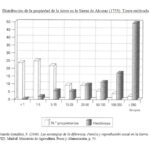In mountain areas such as the Sierra de Alcaraz, land ownership was conditioned by the orography of the territory. In 1753, 28.3% of the land in this mountain range was under cultivation. Of this figure, almost 50% of the cultivation belonged to only 2% of the owners. Likewise, almost half of the total landowners owned only 2% of the arable land. The marked imbalance of ownership translated into different economic benefits: the concentration of land in a few hands meant that 17% of landowners owned more than 1,000 reals of gross produce, a figure that rose to more than 40,000 for the few individuals who owned the most; again, conversely, more than 70% of landowners owned less than 500 reals of produce. The rest of the uncultivated land, 71.7%, could belong to the Council, which was also controlled by the local elites. Livestock farming, like agriculture, showed the same tendency towards concentration in the hands of a few individuals. The survival and future of the less well-off depended on the leasing of land, either for cultivation or as pasture for livestock. These data are but one concrete example of the inequalities that existed in the Ancien Régime and which were perpetuated throughout southern Spain.
Collection: Graphics
Project: 3. Rural world and urban world in the formation of the European identity., 4. Family, daily life and social inequality in Europe.
Chronology: XVIII
Scope: Secondary Education, Baccalaureate, University
Resource type: Graph
Format: Bar chart
Source: García González, F. (2000). Las estrategias de la diferencia. Familia y reproducción social en la Sierra. (Alcaraz, siglo XVIII). Madrid: Ministerio de Agricultura, Pesca y Alimentación, p. 54
Language: Spanish
Date: 2000
Owner: Pablo Ballesta Fernández (Modernalia)
Copyright: © Ministerio de Agricultura, Pesca y Alimentación © Francisco García González © Seminario de Historia Social de la Población
Abstract: Distribution of cultivated land ownership as a reflection of the inequalities of the Ancien Régime
Image
Tags






